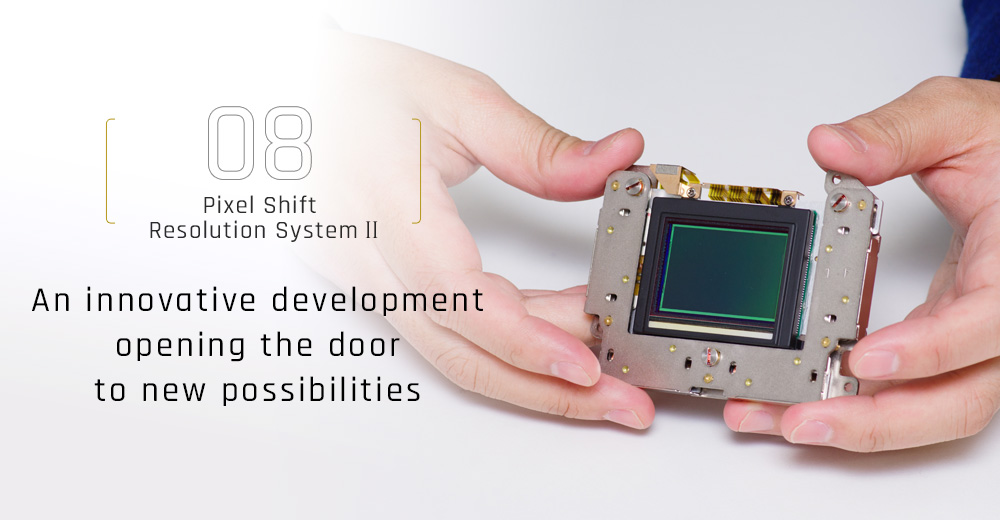
PENTAX digital SLR cameras are equipped with a state-of-the-art SR (Shake Reduction) II mechanism. By shifting this SR unit to the optimal position, camera shake is held to a minimum, regardless of the lens mounted on the camera. PENTAX engineers are always on the search for new ideas, and this SR unit is a treasure trove of technological innovations, and an inspiration for further development. It has motivated PENTAX engineers in a way that transcends job definitions, and contributed greatly to the creation of such innovative functions as Auto Horizon Correction, Composition Adjustment, AA Filter Simulator and ASTROTRACER.
In the next technological step, we equipped the PENTAX K-3 II with the newly developed Pixel Shift Resolution System, a function that built on the inclusion of the SR II unit. It captures four images of the same scene by slightly shifting the image sensor for each image to obtain all RGB data from each pixel. It then synthesizes them into a single super-resolution composite image with true-to-life color reproduction free of false colors.
While incorporating the Pixel Shift Resolution System in the PENTAX K-3 II, we also developed a technology which saves and develops RAW-format images within the camera body. Later, we also developed the Motion Correction function, which automatically detects the degree of subject motion during continuous shooting, then minimizes negative effects during the synthesis process. This function can be turned on or off depending on the photographer’s creative goals. By providing these user-friendly options, the Pixel Shift Resolution System forms a unique system clearly distinguishable from others.

An innovative idea that helped solve a difficult task
Shifting the image sensor by a single pixel requires extremely minute position control. This normally demands that the camera be firmly locked in position (and we do recommend the use of a tripod when employing this function). But PENTAX is also widely known as the leader in field cameras, so being able to use the Pixel Shift Resolution System in handheld photography was a task that engineers simply had to achieve.
After repeated examinations and discussions about this difficult task, it seemed that there was a fundamental incompatibility between handheld photography and high-precision position control. To overcome this, PENTAX had to come up with a truly unconventional and inspired idea.
After reexamining handheld photography from many different angles, and considering all the possible ways of minimizing camera shake during handheld shooting, PENTAX instead considered if it would be possible to take advantage of camera shake. Instead of looking at camera shake as the shifting of the subject from its original position, the company looked at shift as the intentional repositioning of the subject. While the mechanism of the Pixel Shift Resolution System was designed to shift the image sensor intentionally for a certain purpose, engineers were looking for a shift in general: whether the image sensor is purposefully shifted as a part of the camera’s shake-reduction mechanism, or it is unintentionally shifted due to the photographer’s motion during exposure.
This was an idea born from PENTAX’s experience and expertise in developing countless functions over the years. If the team were only looking for ways to develop the Pixel Shift Resolution System, they might never have found the clues leading to this solution.
The camera detects minute camera shake during handheld shooting and closely evaluates the motion, while also analyzing the four separate images before composing a single super-resolution image. PENTAX’s unlimited creativity was the key to realizing handheld photography using the Dynamic Shift Resolution System newly incorporated in the PENTAX K-1 Mark II.


A unique yet orthodox approach
A basic concept at PENTAX is to incorporate meaningful, mainstream developments while also treasuring its unique, original solutions. This is what makes PENTAX so much different from other companies. This approach is not only reflected in the product development flow, but also in the steps taken in technological development.
While featuring an extensive selection of innovative functions, the PENTAX K-1 Mark II is at the same time an “orthodox” field camera, in the best sense of the term. Because the photographer has been released from the requirement of using a tripod during handheld photography using the Pixel Shift Resolution System, the creative boundaries in active field photography have been greatly expanded.













